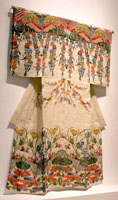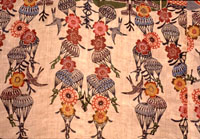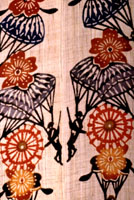Yuken Teruya (Okinawa)
1. Yuken Teruya
2. Color the World
3. Notice Forest
1. Yuken Teruya



gYou-I, You-IhiPaint on Hemp 180~140cmj
Born in Okinawa and now a resident of New York, Yuken Teruya approaches each of his projects with a keen sense of the environments in which he lives. His work often traces the link from nature to consumerism, as well as actively borrowing from both traditional and contemporary sources in his works.
A work entitled gYou-I, You-Ih (Tying Together) appeared in the 2002 Vision of Contemporary Art (VOCA) in Tokyo. In this hybrid work, Teruya used the traditional Japanese craft of bingata, the Okinawan technique of stenciling on cloth, to create a kimono. Upon closer inspection the images are revealed to be those of parachutes and US fighter planes juxtaposed with chrysanthemums, dugongs and flowing water. Tradition is fused with contemporary political tensions in Okinawa. In Okinawa, seeing and hearing US Air Force planes is an ordinary thing in everyday life. Around the dugongs are helicopters, which suggest that the new heliport of the US Air Force threatens the habitat of the dugong in Okinawa.
2. Color the World
The terror of September 11th inspired Teruya, and prompted him to create the piece called Color the World. Teruya mentioned that after the terrorism, all over New York City were seemingly endless appearances of the Star Spangled Banner. This showed a fragile aspect of the United States, which needs something symbolic as the foundation of its identity.
In this work, 196 flags
are placed as according to their countriesf actual geographical allocation.
As a result, for instance, the flags of African countries, which normally contain
green colors, dissolve the color of the nations alongside them. As a result,
the borders of the nations became unclear. By this flag, Teruya succeeded to
show that the geographical situations make up a similar identity in the region,
and these similarities can deconstruct national identity itself. Also in this
work, the size of the influential countries and small countries are all equal
on the same surface, and it suggests the nostalgia of Teruya toward good old
internationalism.
3. Notice Forest
The work Notice Forest shows the linkage between mass consumption and the forest. The use of paper products by fast food restaurants which typify the culture of consumption is one@of the biggest causes of global environmental destruction.
In this work, Teruya tries
to regenerate the spirit of trees. He is inspired by Aristotlefs philosophy
of nature that regards the development of potentiality to actuality as one of
the most important aspects to learn from nature. An example of this is when
an acorn, which is a seed of an oak tree, begins to grow up, it already has
within it the potentiality of an oak tree. Similarly a full grown oak tree is
proof of the potentiality of the acorn. Teruya tries to give rebirth to the
spirit of the trees by his technique using these paper products, since he believes
that there is a spirit of the tree which is contained on the surface of these
paper products which originally comes from trees.
(C) Copyright Shinya Watanabe